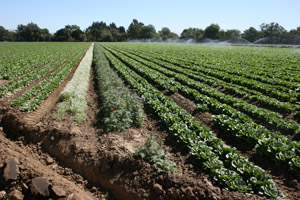Integrated pest management (IPM) programs are especially important to organic fruit and vegetable growers. A critical component of IPM is building and maintaining beneficial insect populations. This process starts with creating a beneficial habitat, and it is where the use of Bt can fill an important role.
One of the advantages of Bt is its specific mode of action.
“Unlike most insecticides, Bt insecticides do not have a broad spectrum of activity, so they do not kill beneficial insects,” notes W.S. Cranshaw, Extension entomologist at Colorado State University. “This includes the natural enemies of insects (predators and parasites), as well as beneficial pollinators, such as honeybees.”
Planting some refuge vegetation for beneficials within field crops as shown in this California field, can help maintain populations of beneficials.
Cranshaw says that’s why , Bt integrates well with other natural controls in an organic program. For example, in Colorado, Bt use to control corn borers in field corn has been stimulated by its ability to often avoid killing beneficials and creating later spider mite problems. Mite outbreaks commonly result following destruction of their natural enemies by less selective treatments.
Dr. Gary Leibee, a researcher at the University of Florida, has found Bt to be especially useful in controlling diamondback moth and cabbage loopers. For Leibee, Bt’s ability to maintain beneficials is another benefit that enters strongly into the equation. “It really is the perfect IPM tool,” he says,”because it only kills the caterpillars and has no effect on predators and parasites (beneficials), which are extremely important in keeping the populations at a low level.”
For organic growers, the maintenance of both beneficial insects and habitats is a one-two punch. The results of a national survey of more than 1,000 organic farmers conducted by the Organic Farming Research Foundation (OFRF) indicates that organic farmers see organic farming as a management system of applying inputs to supplement cultural practices. Organic growers rely heavily on cultural strategies including beneficial habitats, crop rotation, and resistant varieties. Bt is reported as the most commonly used insect control tool, followed by insecticidal soap according to Brian Baker at the Organic Materials Review Institute (as part of the Organic Farming Compliance Handbook). In fact, these materials were the only ones used by more than half of all growers responding to the survey.

